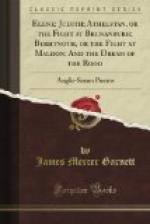[1] Crow’s “Maldon and Brunnanburh,” 1897.
V. The DREAM OF THE ROOD is found in the Vercelli manuscript. Wuelker’s Grundriss gives the literature of the subject to the time of its publication (1885). Soon afterwards Morley’s “English Writers,” Vol. II., appeared (1888), in which an English translation is given (pp. 237-241); also Stopford Brooke, in his “History of Early English Literature” (1892), has given an account of the poem, with partial translation and epitome (pp. 436-443). (See also p. 337 and pp. 384-386 for further notice.) The poem is very briefly mentioned by Trautmann in his monograph on Cynewulf (1898, p. 40). There are some very interesting questions connected with the poem which cannot be discussed here. Was it by Cynewulf? On the affirmative side we find Dietrich, Rieger, Grein, ten Brink, D’Ham, and Sweet. On the negative, Wuelker, Ebert, Trautmann, Stephens, Morley, Brooke, and others. Pacius, who edited the text, with a German translation, in 1873, thinks that we know nothing about the poet. Brooke has propounded a theory, previously adumbrated by the editors of the Corpus Poeticum Boreale, Vigfusson and Powell, that an older poem, possibly of Caedmonian origin, as shown by the long six-accent lines, has been worked over by Cynewulf, with additions, and that it is “his last work” (p. 440). Certain lines of the poem, in the Northumbrian dialect, are found on the Ruthwell Cross, which fact complicates the question of origin. These are compared by Brooke (p. 337). The other upholders of the Cynewulfian authorship think that this Dream, occurring in the early part of Cynewulf’s religious life, led to the longer and more highly finished poem, the ELENE, written near the close of his life. The questions of the relationship of the poem to the Ruthwell Cross and to the ELENE deserve further discussion. With these is connected the question of date, and the poem has been placed all the way from 700 to 800 A.D., even a little before and a little after, possibly 675 to 825 A.D., so as yet there is no common agreement.




